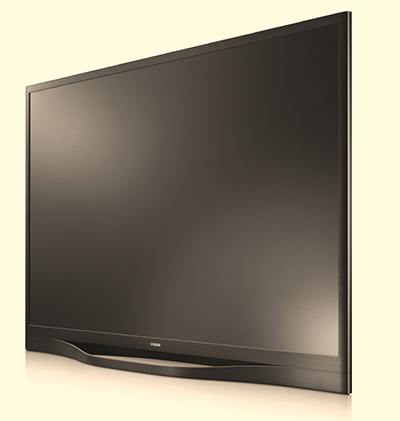
Tom Butts
Summer is usually a slow news time for those of us in the tech industry but in late July, several product launches occurred that could almost serve as a microcosm for the directions in which our industry are heading. In the world of TV set displays, two of the world’s largest consumer electronics manufacturers announced the availability of the first large-screen OLED displays in the U.S. Samsung and LG Electronics introduced 55-inch OLEDs, which will go on sale at selected Best Buy locations in the coming weeks. The product launches follow years of unfulfilled promise on the part of the technology, which, to most observers, provides superior images and lighter and thinner form factors than existing LCD and plasma displays.
As expected, the prices aren’t cheap: The curved version (from both companies) will retail for about $15,000 while the non-curved will sell for around $10,000. Now, in a market where a similar 55-inch LCD set can be had for around $800, why would anyone spend that kind of money? And, with the price of 4K sets already rapidly dropping, will we see similar decreases in OLEDs?
To answer this question, I spoke with Pete Putman, an expert in display technologies, who spoke about the unique challenges in manufacturing OLEDs, which are primarily found in cellphone and tablet screens at the moment.

New OLED sets that hit the market this month are thinner than existing LCD sets. Unfortunately they’ll also make your wallet thinner too. “It’s an expensive process, because the yields are so low,” Putman said. “Between 10-20 percent of the OLEDs that come off the assembly line have enough material defects in them that they cannot be used. It can be perfected over time, but it’s still a challenge.” In addition, the colors in OLEDs (organic light emitting diode), age differently. “Research has shown that the blues in OLEDs can age in about 5,000 hours,” Putman said. This may not make much of a difference with OLED screens in cellphones and tablets that are replaced every few years but consumers hold on to TV sets far longer.
Samsung and LG have been researching OLED for several decades but their announcement of the commercial availability of the 55-inch sets surprised many in the industry, Putman noted. “They really haven’t licked the OLED yields problem, so you’re going to take on the almost impossible challenge of building the airplane while you’re flying it,” he said.
There’s also a bit of one-upsmanship between the two consumer electronics giants, which, combined, accounted for more than 40 percent of all worldwide shipments of TV sets in 2012. “This ‘Hatfield and McCoy’ feud has been going on between LG and Samsung for many years now,” Putman said. “So the costs may be too high right now, and the main reason they’re introducing them is prestige.”
The professional video industry's #1 source for news, trends and product and tech information. Sign up below.
Now contrast that with the announcement several days later from Google of the launch of its Chromecast device. The dongle, which basically allows users to stream video from PCs and mobile devices to a TV set over Wi-Fi, connects to the set via the HDMI port and sells for $35. The devices sold out in less than two days.
The tech world swooned, gushing over the product’s “simplicity” and “openness” (as opposed to Apple’s Airplay, which offers the same features but only over iOS). Nevertheless, until these devices get into the hands of its buyers (around the time you’re reading this), the jury is still out on whether it will be the “Apple TV killer” some pundits declared it to be.
These two back-to-back technology introductions illustrated the contrasting image that TV has today: the attractiveness and wow-factor of the high-end consumer display versus the versatility of mobile and the explosion of choices in how consumers view their content beyond the traditional TV set. (Of course, the irony is that Samsung, the largest provider of OLED screens, uses the technology in their cellphones and tablets).
It basically comes down to image quality and choice. Both will continue to play an important part in TVs future, but at least for OLED, consumer acceptance will come much slower.
Tom has covered the broadcast technology market for the past 25 years, including three years handling member communications for the National Association of Broadcasters followed by a year as editor of Video Technology News and DTV Business executive newsletters for Phillips Publishing. In 1999 he launched digitalbroadcasting.com for internet B2B portal Verticalnet. He is also a charter member of the CTA's Academy of Digital TV Pioneers. Since 2001, he has been editor-in-chief of TV Tech (www.tvtech.com), the leading source of news and information on broadcast and related media technology and is a frequent contributor and moderator to the brand’s Tech Leadership events.

